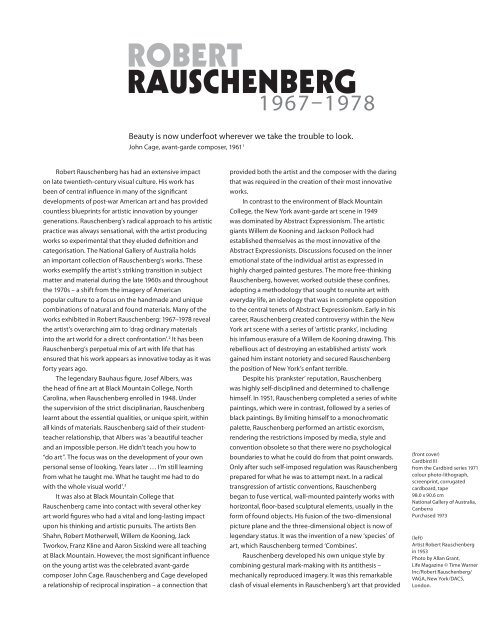Download Room Brochure - National Gallery of Australia
Download Room Brochure - National Gallery of Australia
Download Room Brochure - National Gallery of Australia
You also want an ePaper? Increase the reach of your titles
YUMPU automatically turns print PDFs into web optimized ePapers that Google loves.
1967–1978<br />
Beauty is now underfoot wherever we take the trouble to look.<br />
John Cage, avant-garde composer, 1961 1<br />
Robert Rauschenberg has had an extensive impact<br />
on late twentieth-century visual culture. His work has<br />
been <strong>of</strong> central influence in many <strong>of</strong> the significant<br />
developments <strong>of</strong> post-war American art and has provided<br />
countless blueprints for artistic innovation by younger<br />
generations. Rauschenberg’s radical approach to his artistic<br />
practice was always sensational, with the artist producing<br />
works so experimental that they eluded definition and<br />
categorisation. The <strong>National</strong> <strong>Gallery</strong> <strong>of</strong> <strong>Australia</strong> holds<br />
an important collection <strong>of</strong> Rauschenberg’s works. These<br />
works exemplify the artist’s striking transition in subject<br />
matter and material during the late 1960s and throughout<br />
the 1970s – a shift from the imagery <strong>of</strong> American<br />
popular culture to a focus on the handmade and unique<br />
combinations <strong>of</strong> natural and found materials. Many <strong>of</strong> the<br />
works exhibited in Robert Rauschenberg: 1967–1978 reveal<br />
the artist’s overarching aim to ‘drag ordinary materials<br />
into the art world for a direct confrontation’. 2 It has been<br />
Rauschenberg’s perpetual mix <strong>of</strong> art with life that has<br />
ensured that his work appears as innovative today as it was<br />
forty years ago.<br />
The legendary Bauhaus figure, Josef Albers, was<br />
the head <strong>of</strong> fine art at Black Mountain College, North<br />
Carolina, when Rauschenberg enrolled in 1948. Under<br />
the supervision <strong>of</strong> the strict disciplinarian, Rauschenberg<br />
learnt about the essential qualities, or unique spirit, within<br />
all kinds <strong>of</strong> materials. Rauschenberg said <strong>of</strong> their studentteacher<br />
relationship, that Albers was ‘a beautiful teacher<br />
and an impossible person. He didn’t teach you how to<br />
“do art”. The focus was on the development <strong>of</strong> your own<br />
personal sense <strong>of</strong> looking. Years later … I’m still learning<br />
from what he taught me. What he taught me had to do<br />
with the whole visual world’. 3<br />
It was also at Black Mountain College that<br />
Rauschenberg came into contact with several other key<br />
art world figures who had a vital and long-lasting impact<br />
upon his thinking and artistic pursuits. The artists Ben<br />
Shahn, Robert Motherwell, Willem de Kooning, Jack<br />
Tworkov, Franz Kline and Aaron Sisskind were all teaching<br />
at Black Mountain. However, the most significant influence<br />
on the young artist was the celebrated avant-garde<br />
composer John Cage. Rauschenberg and Cage developed<br />
a relationship <strong>of</strong> reciprocal inspiration – a connection that<br />
provided both the artist and the composer with the daring<br />
that was required in the creation <strong>of</strong> their most innovative<br />
works.<br />
In contrast to the environment <strong>of</strong> Black Mountain<br />
College, the New York avant-garde art scene in 1949<br />
was dominated by Abstract Expressionism. The artistic<br />
giants Willem de Kooning and Jackson Pollock had<br />
established themselves as the most innovative <strong>of</strong> the<br />
Abstract Expressionists. Discussions focused on the inner<br />
emotional state <strong>of</strong> the individual artist as expressed in<br />
highly charged painted gestures. The more free-thinking<br />
Rauschenberg, however, worked outside these confines,<br />
adopting a methodology that sought to reunite art with<br />
everyday life, an ideology that was in complete opposition<br />
to the central tenets <strong>of</strong> Abstract Expressionism. Early in his<br />
career, Rauschenberg created controversy within the New<br />
York art scene with a series <strong>of</strong> ‘artistic pranks’, including<br />
his infamous erasure <strong>of</strong> a Willem de Kooning drawing. This<br />
rebellious act <strong>of</strong> destroying an established artists’ work<br />
gained him instant notoriety and secured Rauschenberg<br />
the position <strong>of</strong> New York’s enfant terrible.<br />
Despite his ‘prankster’ reputation, Rauschenberg<br />
was highly self-disciplined and determined to challenge<br />
himself. In 1951, Rauschenberg completed a series <strong>of</strong> white<br />
paintings, which were in contrast, followed by a series <strong>of</strong><br />
black paintings. By limiting himself to a monochromatic<br />
palette, Rauschenberg performed an artistic exorcism,<br />
rendering the restrictions imposed by media, style and<br />
convention obsolete so that there were no psychological<br />
boundaries to what he could do from that point onwards.<br />
Only after such self-imposed regulation was Rauschenberg<br />
prepared for what he was to attempt next. In a radical<br />
transgression <strong>of</strong> artistic conventions, Rauschenberg<br />
began to fuse vertical, wall-mounted painterly works with<br />
horizontal, floor-based sculptural elements, usually in the<br />
form <strong>of</strong> found objects. His fusion <strong>of</strong> the two-dimensional<br />
picture plane and the three-dimensional object is now <strong>of</strong><br />
legendary status. It was the invention <strong>of</strong> a new ‘species’ <strong>of</strong><br />
art, which Rauschenberg termed ‘Combines’.<br />
Rauschenberg developed his own unique style by<br />
combining gestural mark-making with its antithesis –<br />
mechanically reproduced imagery. It was this remarkable<br />
clash <strong>of</strong> visual elements in Rauschenberg’s art that provided<br />
(front cover)<br />
Cardbird III<br />
from the Cardbird series 1971<br />
colour photo-lithograph,<br />
screenprint, corrugated<br />
cardboard, tape<br />
98.0 x 90.6 cm<br />
<strong>National</strong> <strong>Gallery</strong> <strong>of</strong> <strong>Australia</strong>,<br />
Canberra<br />
Purchased 1973<br />
(left)<br />
Artist Robert Rauschenberg<br />
in 1953<br />
Photo by Allan Grant,<br />
Life Magazine © Time Warner<br />
Inc/Robert Rauschenberg/<br />
VAGA, New York/DACS,<br />
London.
















